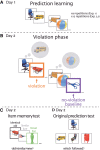Mnemonic prediction errors promote detailed memories
- PMID: 34663695
- PMCID: PMC8525423
- DOI: 10.1101/lm.053410.121
Mnemonic prediction errors promote detailed memories
Abstract
When our experience violates our predictions, it is adaptive to update our knowledge to promote a more accurate representation of the world and facilitate future predictions. Theoretical models propose that these mnemonic prediction errors should be encoded into a distinct memory trace to prevent interference with previous, conflicting memories. We investigated this proposal by repeatedly exposing participants to pairs of sequentially presented objects (A → B), thus evoking expectations. Then, we violated participants' expectations by replacing the second object in the pairs with a novel object (A → C). The following item memory test required participants to discriminate between identical old items and similar lures, thus testing detailed and distinctive item memory representations. In two experiments, mnemonic prediction errors enhanced item memory: Participants correctly identified more old items as old when those items violated expectations during learning, compared with items that did not violate expectations. This memory enhancement for C items was only observed when participants later showed intact memory for the related A → B pairs, suggesting that strong predictions are required to facilitate memory for violations. Following up on this, a third experiment reduced prediction strength prior to violation and subsequently eliminated the memory advantage of violations. Interestingly, mnemonic prediction errors did not increase gist-based mistakes of identifying old items as similar lures or identifying similar lures as old. Enhanced item memory in the absence of gist-based mistakes suggests that violations enhanced memory for items' details, which could be mediated via distinct memory traces. Together, these results advance our knowledge of how mnemonic prediction errors promote memory formation.
© 2021 Bein et al.; Published by Cold Spring Harbor Laboratory Press.
Figures


References
Publication types
MeSH terms
Grants and funding
LinkOut - more resources
Full Text Sources
Medical
